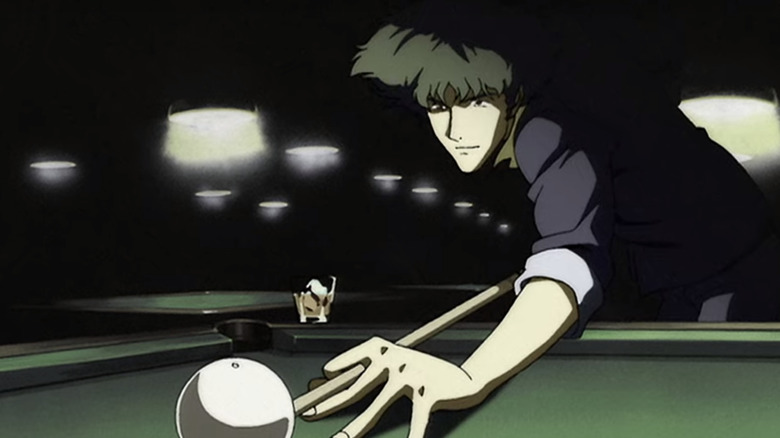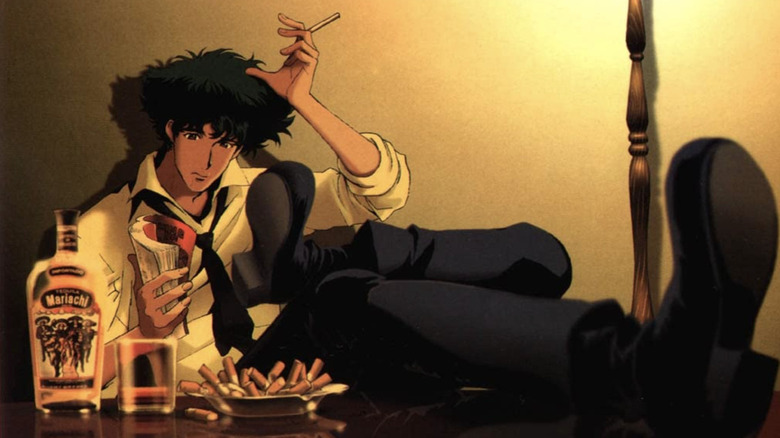How Cowboy Bebop Paid Tribute To Two Legends Of French Filmmaking
"Cowboy Bebop" may be the most classically cinematic anime out there. The gun-toting, cigarette-smoking main character resembles hard-boiled noir stars like Humphrey Bogart and Western icons like John Wayne. But those weren't the only classic film genres that inspired the creators of "Cowboy Bebop." The 20th episode of the series, "Pierrot le Fou," was named after the 1965 film from French New Wave director Jean-luc Godard. The episode also pays tribute to the films of Jean-Pierre Melville, specifically "Le Samouraï" and "Le Cercle Rouge," among other French New Wave classics.
Episode 20 was always my favorite "Bebop" episode. The villain is a superhuman assassin that has regressed to a child-like mental state. He is impossible to kill but, once wounded, devolves into hysterics. "Episode 20 is a weird one to like," the series director Shinichiro Watanabe admitted (via SakuraBlog). "I guess French people live up to their reputation of being odd." Watanabe concedes that the episode is probably so strange and cinematic "because it was inspired by many French filmmakers like Godard and Melville."
The episode takes obvious influence from Melville in its opening scene. "The billiards table in the episode is a reference to Melville's 'The Samurai,' and I was sad to see that the reference flew over most people's head in Japan,'" Watanabe recalled. The scene to which Watanabe is referring is actually in Melville's 1970 crime film "Le Cercle Rouge." The scene is remade almost shot for shot, mimicking memorable angles like the birds-eye view of the pool table.
Melville and Godard were huge influences
"Le Samouraï" also bears a lot of similarities to the "Cowboy Bebop" episode in question. For instance, the villain in the 1967 french film has a cane — just like the formidable Mad Pierrot. "Cowboy Bebop" is inspired by the same rugged noir characters as Jef, the leading man in "Le Samouraï." They both stalk the shadows and stave off serious injuries in their final battle. The halls and rollercoasters of Space Land closely resemble the subways of "Le Samouraï." There is also a bridge in "Le Samouraï" that appears to have inspired the bridge where Jet meets his contact in "Pierrot le Fou."
The "Bebop" episode takes inspiration from other French New Wave films as well. Mad Pierrot's backstory is told in black and white flashbacks through still or stop-motion images. These flashbacks depict Pierrot hooked up to wires and surrounded by doctors in white uniforms. Their style and content resembles Chris Marker's 1962 experimental science-fiction film "La Jetée."
The "Pierrot le Fou" episode also references its namesake when Mad Pierrot causes a huge explosion. Such an explosion was the cause of death for the French film's main character. There are also smaller nods to the 1965 classic, like the lights on the sign of Spike's billiards club, which resembles the sign for the Las Vegas club in the film.
"Cowboy Bebop" has an eclectic set of influences that makes it an unforgettable and irreplaceable piece of art. By taking inspiration from cinematic geniuses like Godard and Melville, the series creators followed in their aesthetic footsteps. The universe of "Cowboy Bebop" is as beautiful and inventive as a French New Wave film, and now we know why.

